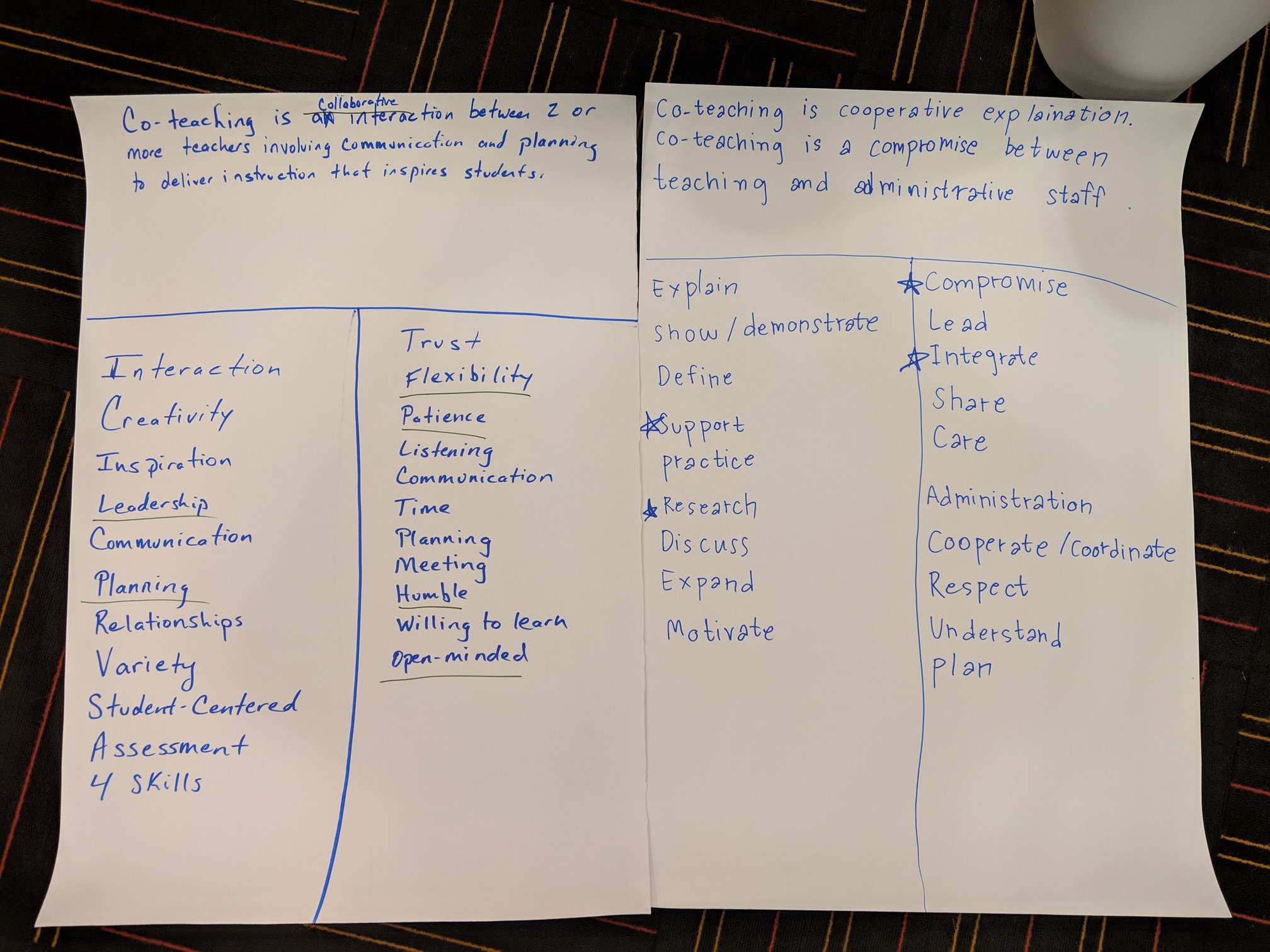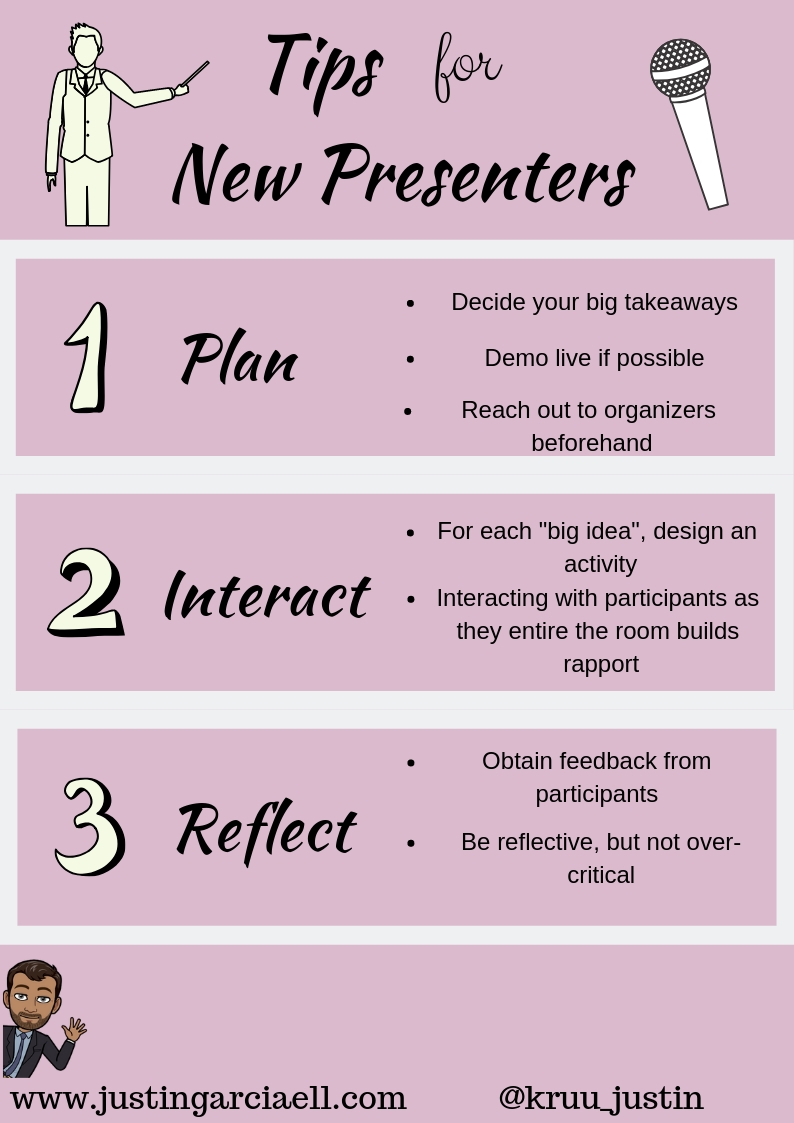My Experience as a New Presenter
Ever since I hopped on the Twitter bandwagon, I started engaged with like minded professionals in the field, specially with ELL related pedagogy. It was the summer, so I had the opportunity to immerse myself in Twitter chats and slow book club chats, which helped me expand my repertoire of ELL best practice strategies.
It didn’t take long for another like minded professional, @Tan_Hyun, to encourage me to showcase my ideas at a conference.
I was taken aback. Me? Get up in front of a group of critical adults and share stuff? Kids I can manage, but adults? No way. I’m comfortable being the participant of these things, not the presenter. And surely others have already been to some talk / workshop about what strategies that I use in the classroom.
However, Tan (as well as other professionals I know on Twitter), persisted. Information has never been more accessible, and teachers can take advantage of that accessibility and share what they know. Thus, I decided to take the plunge and submit a proposal about Co-Teaching (specifically, starting a Co-Teaching model from scratch). to TESOL Thailand 2019; and was accepted.
I’ve been to loads of conferences and workshops in my years of teaching. Some better and more relevant than others, but presentation style aside, relevant information is solely based off of the participant. I myself was questioning whether or not that my experience starting a Co-Teaching model would be useful. I kept asking myself the questions; what can participants take away from this? What would make it useful and relevant? What would be the biggest takeaways? I was riddled with self doubt and even considered pulling out of the conference.
I’ve been trying to find that medium, especially in a role of Co-Teaching, of translating what you already know so it’s accessible to a wider audience. We’ve all at one point had that professor whose previous job was a rocket scientist (or something else as just as cognitively impressive), but couldn’t teach algebra if their life depended on it. The curse of knowledge is assuming everyone around you has the same understanding as you, which is simply untrue. It’s safer to start from scratch than assuming everyone is in the know.
Pro Tip 1: Ask yourself, “What can attendants gain from this information?” and have that guide your presentation.
I spent a considerable amount of time preparing for my first presentation, and I encourage new presenters to do the same. If my activities and slideshow is rocky, I’ll be at the very least organized and presentable, right?! What helped me the most was organizing what I needed on paper. Outlining how I will present information, what information is going to be presented in what order, and brief explanations of activities I’ll facilitate helped organize my initial ideas all in an outline format. From there, I was able to narrow down the information and set rough estimates of timing for each part of my presentation.
Pro Tip 2: Contact event organizers for information about the room layout and provided materials.
Reaching out to the organizers of the conference was also helpful in getting a feel of the room and what resources are available. I asked about the room set up (do they have tables? Chairs? How many? Tape? Projectors? Computers?). With that information, I was able to tweak my resources accordingly. Room specifics were somewhat clear, but I prepared for best and worst case scenarios. This was. . .a choice. I looked a bit ridiculous lugging a massive tote bag full of poster paper and mini white boards around the airport.
Pro Tip 3: Adopt a minimalist mindset with using materials. It’s less wasteful, plus lugging stuff around airport terminals is not fun.
Also, demoed the presentation for willing teachers from surrounding schools on a Saturday a month before the conference. I wanted to not only rehearse the information in front of a live audience, but I wanted to be sure I get feedback regarding the content. This was probably the most valuable part of my preparation; after the demo, I tweaked a lot of information for the real deal.
Pro Tip 4: Demo in front of a live audience if possible. Treat them to coffee, cookies, fruit, etc. to show appreciation.
I was excited to see my name when the conference schedule was released! It felt so official to have my abstract posted with a bit of background information and my Twitter handle. However, I wasn’t so excited to see 15 other presenters showcasing research / a workshop at the same time as me. Also, I noticed most of the presenters were geared towards research conducted on university students. This helped me think about what my future target audiences could be, namely elementary teachers. Also, there wasn’t a tremendous amount that seemed to be targeted for lower primary school. If I were to do another presentation, it would be about ELL strategies that teachers can take back and apply directly in their classrooms. Ideally, the strategies would be transferable across all grade level areas.
Pro Tip 5: Knowing the general audience of attendants can help presenters develop material that’s relevant.
My presentation was titled; “Co-Teaching from Scratch: Putting Plans Into Action”. The purpose of this presentation was to share the steps we took for starting a Co-Teaching program at my current school. Defining what Co-Teaching is in our context and building relationships between both administration and teachers is (in my experience) often overlooked when creating the groundwork for a Co-Teaching model, so participants were to engage in an activity that helped them develop a definition for Co-Teaching as well as brainstorm ways they can incorporate more collaborative practice in their context. In the end, I supplied participants with an electronic Google Folder full of materials as well as the presentation.
Based on the feedback I received, creating a definition was the most valuable part of the presentation. According to participants, that was something that they have not thought of and found useful to help guide the development of their practice. This was only a draft of the definition, but ideally it would be written with administrators as well so everyone is on the same page.
If I were to do it differently, I would provide a bit of background on Co-Teaching. I made the mistake of assuming too much; not everyone is familiar with ideas like Co-Teaching models, the importance of building relationships, or parity. Briefing those beforehand would help give some context to Co-Teaching newcomers who are interested in the practice.
Pro Tip 6: Delving into teacher background knowledge can help contextualize content.
It was a great experience presenting for the very first time at a big conference. I look forward to using this experience to construct bigger, better presentations in the future. While presenting is not for everyone, I would encourage teachers to showcase a part of their practice that they enjoy teaching (or something else that works for their students), whether it be in front of colleagues at school or educators at a conference. For those more inclined to write, try creating a blog or asking an existing blog owner to be a guest writer.
By sharing information, we can bridge the gap of distance and support one another with best practice!




Sawatdee krup, khone Justin!
This is a fantastic article with lots of great PRO tips that I need to follow as well. I think I do the first two steps well, but man, do I bomb on the reflect part. I know I need to send a survey out at each presentation to help me reflect, but I always run out of time. Did you notice that I record my sessions on my mini iPad? That’s how I reflect, but I need to get participants’ reflections as well!
THANK YOU for taking the jump because now others will benefit as well!